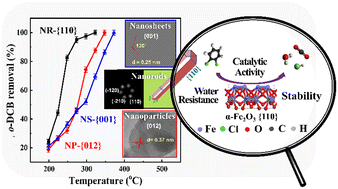Catalytic activity, water resistance and stability of hematite nanomaterials in oxidative removal of polychlorinated aromatic hydrocarbons can be simultaneously enhanced through facet engineering†
Abstract
Iron oxides are commonly used catalysts for the removal of polychlorinated aromatic hydrocarbons from incinerators. Here, we provide a proof of concept that facet engineering can be exploited to simultaneously improve the catalytic activity, water resistance and stability of iron oxides. Using 1,2-dichlorobenzene oxidation as a surrogate reaction, we show that α-Fe2O3 nanorods with predominantly exposed {110} facets (NR-{110}) exhibit lower T50% and T90% (temperatures of 50% and 90% removal) and higher CO2 selectivity under a dry condition than α-Fe2O3 nanoparticles with {012} facets, α-Fe2O3 nanosheets with {001} facets, and commercial α-Fe2O3. NR-{110} also exhibits superior water resistance (without exhibiting the “V-shaped” curve in 1,2-dichlorobenzene removal originated from the competitive adsorption of water) and much better stability. Spectroscopic evidence based on pyridine-adsorbed Fourier transform infrared and X-ray photoelectron spectroscopy, chemisorption analysis based on O2 temperature-programmed desorption, H2 temperature-programmed reduction and H2O temperature-programmed desorption and theoretical calculations demonstrate that the higher abundance of Lewis and Brønsted acid sites, higher concentration of surface active oxygen, more negative adsorption energy and lower C–Cl bond broken energy barrier associated with the (110) facet collectively enable fast reaction kinetics and more complete contaminant destruction. Additionally, the facet-specific interaction mode of water gives greater water resistance, and the abundant Brønsted acid sites on the (110) facet effectively provide H+ to prevent the accumulation of chloride ions, thus enhancing stability.

- This article is part of the themed collections: Nanomaterials in air and Environmental Science: Nano Recent HOT Articles


 Please wait while we load your content...
Please wait while we load your content...